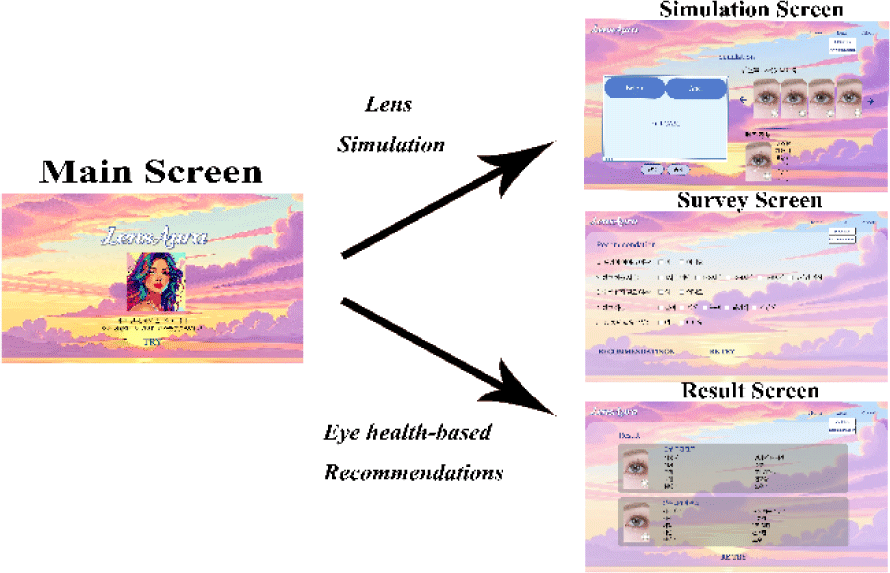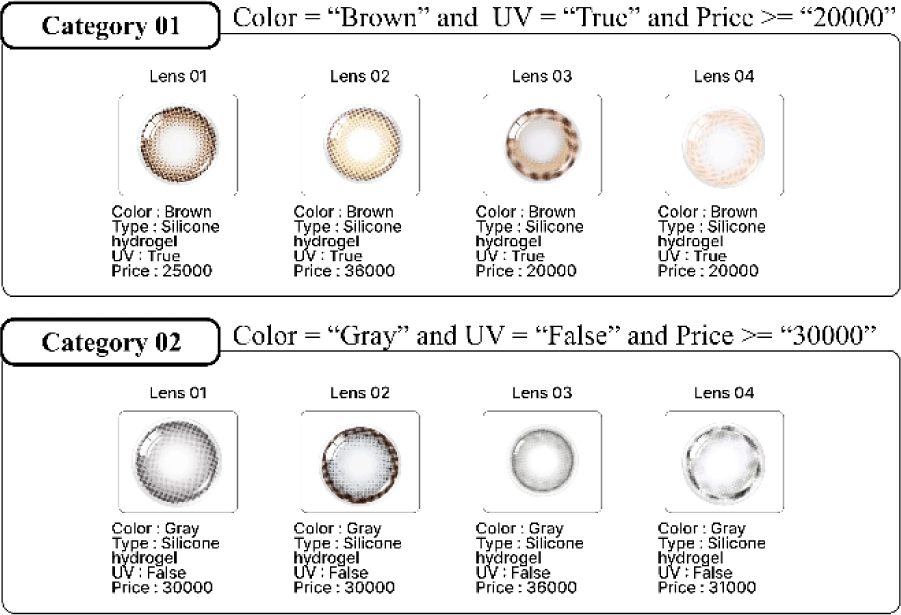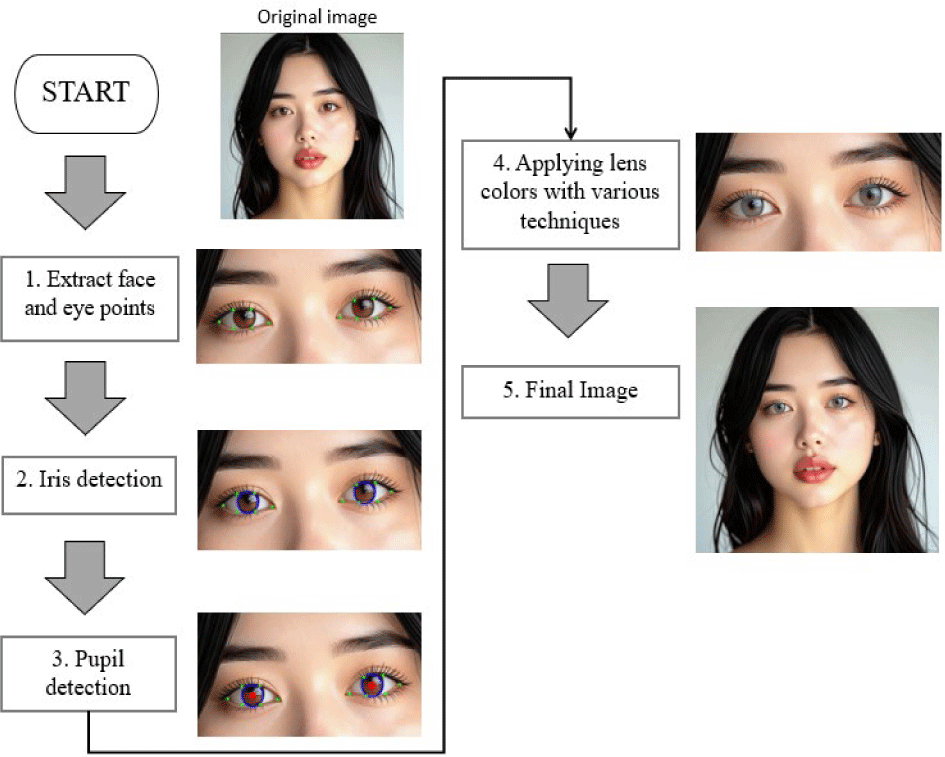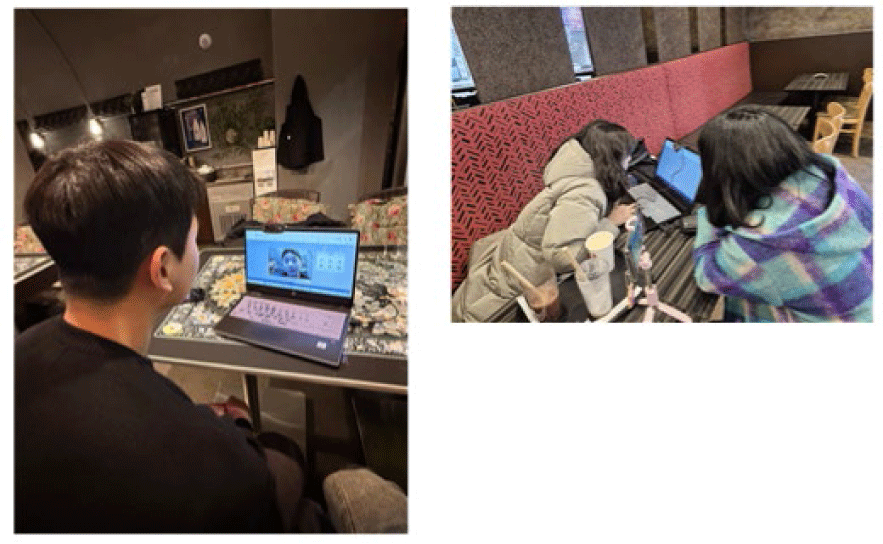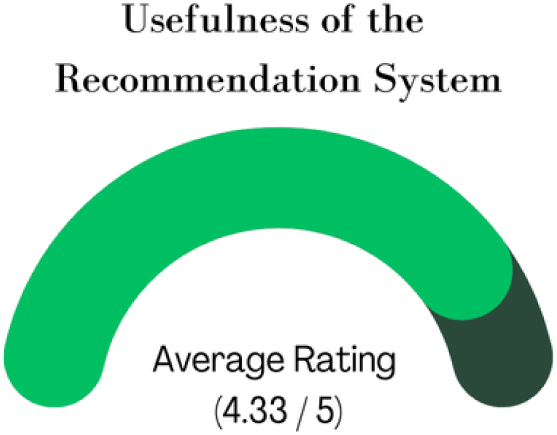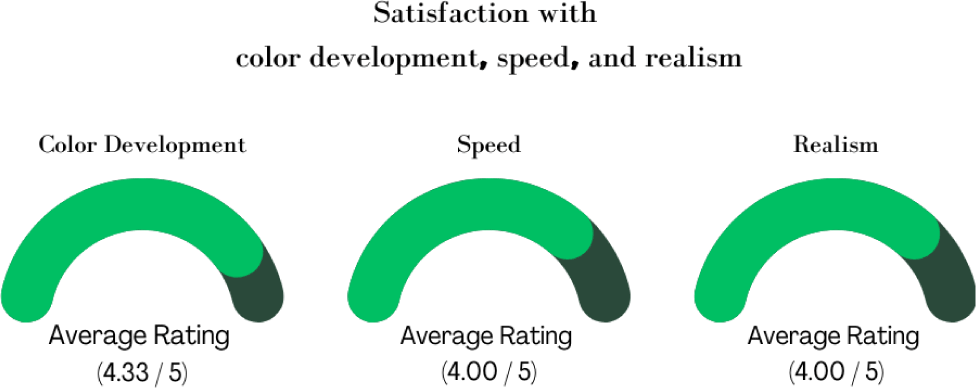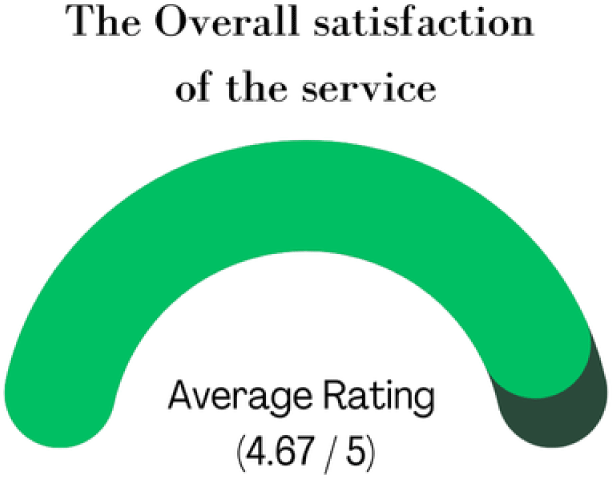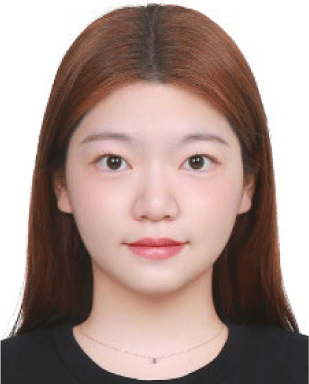I. INTRODUCTION
With recent advancements in makeup technology and digitalization within the beauty industry driven by developments in information technology, contact lenses have emerged as significant beauty items. Previously used primarily to aid vision, lenses are now widely utilized to express individuality through diverse colors and patterns. They have also become integral to makeup effects within augmented reality (AR) filters. Seo et al. [1] analyzed the effects of cosmetic color contact lenses on the perceived image of female college students. Additionally, according to a survey conducted by the Daejeon Metropolitan Branch in 2006, 48.7% of adolescents reported having worn colored lenses, and 54.2% expressed intentions to wear them in the future. These findings highlight the positive impact colored lenses have on college students' self-image and suggest their growing significance as a cosmetic tool.
Currently, no lens simulation services specifically address eye health considerations. Although several companies provide lens simulation services, each has notable limitations. For instance, Perfect Corp offers a virtual lens simulation feature but does not allow consumers to virtually try on the actual lenses available for sale. Consumers can digitally test lenses created by the company. However, this simulation does not directly facilitate immediate purchases. Instead, this strategy primarily serves as a marketing tool to showcase the company's technology, which is then customized according to the specific needs of collaborating businesses [2].
Eyecandys offers a virtual simulation service specifically for their colored contact lens products. This service allows users to compare before-and-after visuals of various colored contacts and preview how the lenses will appear on camera with Instagram filters. This intuitive approach enables users to visualize the aesthetic impact of wearing the lenses and receive feedback through social media. However, the service only previews the color changes, making it difficult to assess the actual fit or suitability regarding individual eye health [3].
Colored Contacts provides a service allowing users to virtually apply various colored lenses to their own photos or model images and immediately observe the visual changes. It also conveniently links users to pricing details and retailers for easier purchases. Nevertheless, while the platform enables product filtering based on certain conditions, it lacks personalized recommendations tailored to individual eye health requirements [4].
Current lens simulation services offer valuable virtual experiences for users selecting lenses, but they often overlook detailed lens information and personalized recommendations regarding individual eye health conditions. This study aims to address these gaps by integrating a lens recommendation system focused on eye health with virtual simulation capabilities, thereby enhancing user satisfaction. Fig. 1 visually illustrates the differences between traditional lens simulation flows and the proposed simulation method in this study.
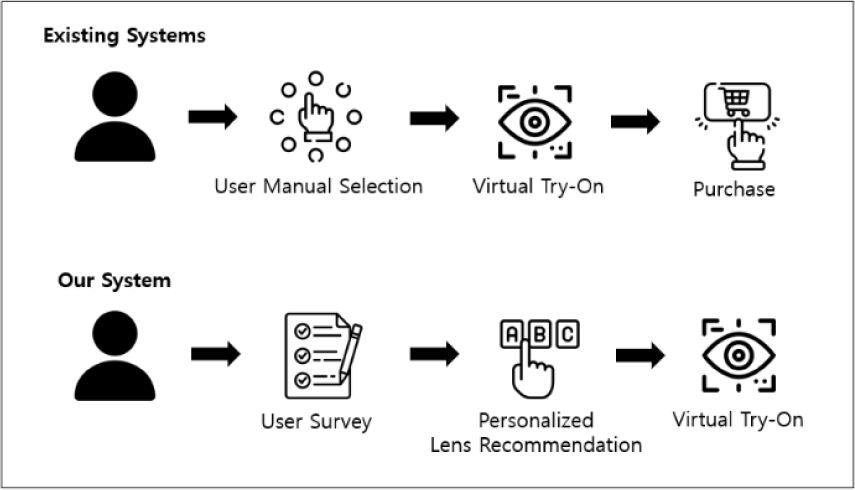
In [5], Kim et al. surveyed the use of glasses and contact lenses for vision correction and eye protection among the general public from their teens to their fifties and analyzed preferences and purchasing trends by age and gender. The survey results showed that women in their 20s most preferred contact lenses for ‘cosmetic reasons,’ and re-spondents in their teens and twenties showed a familiarity with the digital environment and a sensory consumption tendency, as they mainly purchased lenses through SNS advertisements and online shopping malls. In particular, the proportion of ‘cosmetic’ among the purposes of wearing contact lenses was high, and the experience of wearing contact lenses often began in middle and high school, confirming that this age group is the main consumer group in the color lens market. The results of this study support the idea that AR-based color lens simulation services can have high demand and marketability, especially among users in their teens and twenties, and suggest that providing customized simulations can be a key factor in satisfying the desire for pre-purchase experience and increasing reliability and satisfaction with actual wear in the cosmetic-centered lens selection process.
To inform our research, we conducted an online survey targeting teenagers and young adults in their teens and 20s who frequently use contact lenses. A total of 36 respondents participated, with approximately 80% being female. The majority of respondents were in their 20s, with a small number of teenagers also participating. The survey explored respondents' lens usage experiences, purchasing habits, selection criteria, and their perceptions and needs regarding AR-based lens simulation services.
Fig. 2 presents the survey results. Most respondents indicated wearing their lenses once or twice a week, typically for durations of 5–7 hours or more. This suggests lenses are worn regularly or for special occasions. Regarding purchasing methods, respondents predominantly favored brick-and-mortar stores. Price, tint availability, and comfort emerged as key factors influencing their choices. Some respondents further highlighted specific attributes such as lens diameter, material, and oxygen permeability as essential criteria. Awareness of augmented reality lens simulation services existed among about half the respondents, though many had not actually used these services. Major reasons cited for non-use included unnatural color representations and limited lens variety. Respondents also expressed interest in service enhancements, notably an expanded range of lens options, improved color accuracy, customizable expe-riences, and educational content tailored to first-time users.

Based on these findings, we decided to develop a lens simulation service that provides comprehensive information on various lens brands and products, enhances coloration accuracy, and incorporates a customized recommendation system to help users easily select the most suitable lenses.
This paper is organized as follows: Section II reviews relevant prior research. Section III describes the methodology proposed in this study. Section IV presents the performance evaluation methods and experimental results. Finally, Section V concludes with the implications and significance of our findings.
II. RELATED WORKS
Advances in virtual makeup experience technologies provide consumers with the convenience of virtually trying different makeup styles before purchasing, positively influencing their buying decisions. The lens virtual simulation system developed in this study builds upon the successful applications of these virtual makeup technologies.
Kim [6] explored the effects of virtual reality (VR) and augmented reality (AR) on makeup education. The study anticipated that VR-AR services would set new trends by improving user experiences and enabling personalized education. Conducted among female students enrolled in beauty-related majors at K University, the research analyzed how VR-AR experiences impact makeup behaviors. Results highlighted the importance of visual immersion and experiential elements, suggesting that expanding VR-AR services offering diverse experiences and options could significantly enhance practical makeup application.
Joo [7] investigated how augmented reality virtual makeup services influence consumer purchasing behaviors, particularly amid the rise of non-face-to-face interactions. Through surveys examining experiential marketing via AR, the study identified immersion, interactivity, presence, escape, education, and aesthetics as influential elements in consumer engagement. Results indicated that AR experience preferences varied by demographic factors such as age and gender, as well as purchasing patterns. Notably, frequent cosmetics buyers valued escape aspects more significantly. These findings underscore the necessity of diverse consumer data and customized approaches to enhance consumer satisfaction and effectively drive purchase behaviors.
Ultimately, this research aims to enable consumers to virtually test makeup products similarly to lenses, assessing color and design impacts on personal appearance. The proposed service facilitates real-time lens trials via socket connections, photo saving features, and a recommendation system considering comfort and eye health, helping users make informed purchasing decisions.
Similarly, previous studies have attempted to improve consumer experience through customized virtual fitting technology. In [8], Shin et al. proposed a mobile application called ‘Moarens’ that analyzes the user’s eye information to recommend color contact lenses and provides customized experiences through virtual fitting functions. The study was conducted to resolve consumer inconveniences in the process of purchasing colored contact lenses, where simulation before wearing is difficult due to hygiene issues, and to help select more precise customized lenses. The researchers analyzed the user’s eye width and iris diameter using a fuzzy algorithm and recommended lens diameter and color based on the results. In addition, they maximized user experience and helped with product selection by visually providing the user’s actual eye photos with the lens wearing appearance through image synthesis techniques. The app also provides functions such as lens search of various brands, filtering by conditions, and user review ratings, and they plan to secure expandability as a platform by linking the purchase and payment systems in the future. This study is significant in that it presents a technology-based user-centered service for selecting beauty products by combining a personalized recommendation algorithm and visual feedback functions.
III. PROPOSED METHOD
In this study, we implemented a web service designed to recommend contact lenses based on eye health considerations and enable users to virtually try the recommended lenses. The overall workflow of the web service is illustrated in Fig. 3. When users access the lens recommendation page from the main interface, they first complete a survey to specify their preferences and health-related criteria. These inputs are then analyzed by the system to generate personalized lens recommendations. On the results page, users can view recommended lenses and select specific ones to virtually try them through a simulation screen. Alternatively, users can directly access the virtual simulation feature from the main page.
The recommendation algorithm, shown in Fig. 4, utilizes content-based filtering to recommend lenses that match an individual's eye health condition. Users answer a questionnaire about a variety of conditions, including dry eyes, wear time, price preferences, and UV protection needs. For example, they answer questions like “Do you have dry eyes?”, “How many hours do you usually wear your lenses?”, “What is your price range?”, and “Do you need UV protection?”. Lenses are filtered based on each answer, and lenses with similar conditions are grouped together. As shown in Fig. 5, lenses that meet the criteria of “brown color+UV protection+$20,000+” are grouped into one group (Category 1), and lenses that meet the criteria of “gray color+no UV protection+$30,000+” are grouped into another group (Category 2). This process recommends lenses in the appropriate group, making it easy for users to select lenses that meet their needs based on a combination of eye health, user comfort, and lens compatibility.
The virtual try-on functionality was implemented using OpenCV and Dlib, following the workflow detailed in Fig. 6.
-
Step 1) Detect Faces and Eye Regions: We used Dlib’s face detection module to identify faces in the input image. From the detected face, we extracted 68 facial landmarks and focused on the points around the eyes. Using these landmarks, we calculated the position and size of the eyes and estimated the center of the iris and pupil.
-
Step 2) Iris Detection: Using the eye landmarks, we computed the eye center and set the radius of the iris. The horizontal width of the eye was used to determine the size of the iris. These measurements allowed us to approximate the iris location and dimensions.
-
Step 3) Pupil Detection: The pupil, located within the iris, was estimated to be about 40% of the iris size. Its center and radius were calculated based on the same eye landmarks. These values were used to accurately render the pupil structure within the simulated eye.
-
Step 4) Apply Lens Color using Various Tech-niques: The user-selected lens color, provided in HEX format, was converted to BGR format for OpenCV processing. The lens effect was applied exclusively to the iris area, with the pupil area left transparent to create a natural “donut” shape that simulates real lens wear.
To blend the lens with the original image, we used OpenCV’s cv2.add() function. The transparency (alpha value) of the lens was adjusted to maintain visibility of the pupil boundaries. Additionally, a blur was applied to soften the edges and achieve a more seamless integration between the lens and the eye. The final output displays the user with the selected virtual lenses applied. Algorithm 1 presents code snippets for pupil detection and lens color application.
Algorithm 1. Detect Pupil in Image.
1 # Step 1: Initialize face detector and landmark
2 predictor
3 face_detector initialize dlib face detector
4 landmark_predictor initialize dliblandmark
5 predictor
6 # Step 2: Define detect_pupil function
7 function detect_pupil(image):
8 grayscale_image convert_to_grayscale(image)
9 faces detect_faces(grayscale_image,
10 face_detector)
11 pupils [ ] # List to store pupil positions and
12 sizes
13 for each face in faces:
14 landmarks get_eye_landmarks(face,
15 landmark_predictor)
16 pupil_center, pupil_radius
17 calculate_pupil(landmarks)
18 append (pupil_center, pupil_radius) to
19 pupils
20 return pupils
21 # Step 3: Define apply_lens function
22 function apply_lens(image, prdCode,
23 userColor):
24 pupils detect_pupil(image)
25 userColor_BGR convert_to_BGR(userColor)
26 for each (pupil_center, pupil_radius) in
27 pupils:
28 lens_layer create_lens_layer(pupil_center,
29 pupil_radius,
30 userColor_BGR) # Donut-shaped lens
31 image blend_lens(image, lens_layer,
32 pupil_center)
return image
In this study, we implemented a client-server communication system using WebSocket to enable real-time virtual lens application. WebSocket allows continuous, bidirectional communication between the client and server, facilitating the rapid exchange of data required for virtual makeup effects such as lens try-on.
Once a WebSocket connection is established, the server actively monitors connection status and logs connection or disconnection events. When a user sends an image, the server follows the procedure outlined in Algorithm 2: it first decodes the image data and converts it into a format compatible with OpenCV. If the user-selected effect is a lens, the server invokes the apply lens function to apply the chosen lens color and style. The processed image is then encoded in base64 format for return to the client.
This architecture enables smooth and seamless updates, creating a video-like transition effect as users change lenses. As a result, the virtual try-on experience feels more dynamic, realistic, and immersive.
Algorithm 2. WebSocket server process.
1 Initialize websocket server
2 procedure OnClientConnect
3 Print “Client connected”
4 end procedure
5 procedure OnClientDisconnect
6 Print “Client disconnected”
7 end procedure
8 procedure OnClientSendsImage(image)
9 Decode image data
10 Convert image to OpenCV-compatible format
11 Extract makeup type and product code from
12 user input
13 if makeup type = ‘lens’ then
14 Apply apply lens function with selected
15 color and lens
16 end if
17 Encode processed image to base64 format
18 Send transformed image back to client
19 end procedure
IV. THE RESULTS OF A STUDY
The usability evaluation conducted in this study aimed to assess how effectively and satisfactorily users could interact with the augmented lens simulation, using a prototype that incorporated the proposed features.
The participants selected for the usability evaluation were familiar with the concept of augmented lens simulation. Each participant was provided with a PC to operate the prototype and a mobile device to complete a post-experiment survey. During the evaluation, participants' reactions, behaviors, and any signs of discomfort were recorded and photographed to capture authentic user experiences in a natural setting. Fig. 7 shows a subject photograph.
Before starting the experiment, participants received a brief introduction to the Lens Simulation system, including an overview of its features and the purpose behind its development. They were then provided with a task scenario outlining the specific actions they would be expected to perform during the session (Table 1).
In this experiment, we aimed to evaluate several key aspects of the system: the perceived realism of the lens augmentation technology, user satisfaction with the lens color, the speed and overall satisfaction with the simulation, and the perceived usefulness of the eye health-based recommendation system. To achieve this, a post-experiment survey was conducted using a 5-point Likert scale (1: not at all, 2: slightly, 3: moderately, 4: yes, 5: very much). In addition, participants were encouraged to verbalize their thoughts during the session, and further qualitative feedback was gathered using the think-aloud method with informed participants (Table 2).
All participants successfully completed the assigned tasks, achieving a 100% task success rate. In both Task 1: Lens Simulation Experience and Task 2: Eyeglass Recommendation System, users found it easy to locate and navigate to the relevant pages, indicating that the interface was intuitive, and the features were readily accessible.
The results of analyzing the usability of the recommendation system provided in this study are shown in Fig. 8. Participants generally responded positively to the concept of receiving personalized lens recommendations based on their eye condition. However, additional feedback revealed some dissatisfaction with the limited variety of results. This sentiment was echoed in the think-aloud sessions, highlighting the need to expand the underlying lens database to provide more diverse and tailored recommendations.
The lens simulation service was evaluated based on three key aspects: coloration, realism, and speed. Satisfaction ratings for each aspect are shown in Fig. 9. Fig. 10 shows the overall user satisfaction with the service.
Despite the generally positive results, qualitative feedback from the think-aloud sessions revealed areas for improvement particularly in color accuracy. For example, Tester A remarked, “As someone who wears brown lenses most of the time, it's disappointing that the natural color rendition is not as good as it could be.” Similarly, Participant C noted, “Some lenses look unnatural or the colors don’t appear as natural as expected.”. These insights emphasize the importance of refining the color processing algorithms and expanding the lens library to enhance the realism and variety of lens options available.
V. CONCLUSION & FUTURE PLAN
In this study, we introduced a lens-augmented simulation service that integrates a lens simulation prototype with an eye health-based recommendation system. To validate our approach, we reviewed previous studies and evaluated the usability of existing lens simulation services among actual users.
Based on our findings, we recommend two primary directions for future research. First, further investigation into the usability and real-world impact of the recommendation system is needed. Although our evaluations confirmed the service’s potential to guide lens selection and influence pur-chasing decisions, it is essential to quantify its effect through specific performance metrics. Second, enhancements to the lens augmentation simulation should be pursued to improve overall service quality. While valuable feedback was received regarding features like lens coloring and the recommendation mechanism, technical and time constraints limited their full implementation.
The culmination of our research is the Lens Aura application. Lens Aura enables users to virtually try on different brands of lenses and obtain personalized recommendations based on their eye health. The application is structured around five key screens: the main screen, menu selection screen, recommendation screen, simulation screen, and team introduction screen.
In summary, our usability evaluation demonstrates that the Lens Aura service is sustainable and useful, with promising potential to affect lens purchasing behavior. Nonetheless, addressing the technical limitations and extending the evaluation beyond the prototype stage are critical next steps for future studies.

